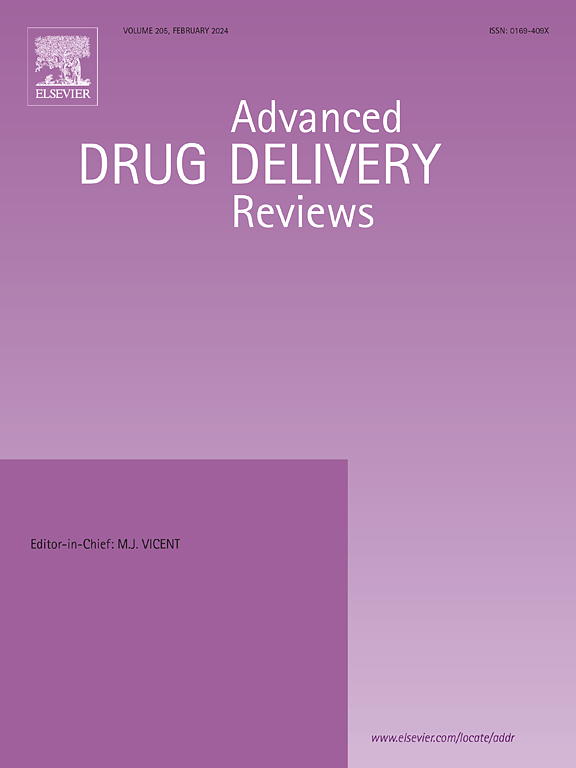用碳基纳米生物传感器增强类器官技术:进展、挑战和未来方向
IF 17.6
1区 医学
Q1 PHARMACOLOGY & PHARMACY
引用次数: 0
摘要
各种碳基纳米材料(CBNs)已被用于开发纳米和微尺度的生物传感器,能够实时和连续监测活生物系统中的生化和生物物理变化。将基于cbn的生物传感器集成到类器官中,最近为类器官的发展、疾病建模和药物反应提供了有价值的见解,增强了它们的功能并扩大了它们在各种生物医学领域的应用。这些生物传感器在研究神经系统疾病、心血管疾病、癌症进展和肝毒性方面尤其具有变革性,在这些领域,精确、无创监测对于理解病理生理机制和评估治疗效果至关重要。本文介绍了采用石墨烯、碳纳米管(CNTs)、氧化石墨烯(GO)、还原氧化石墨烯(rGO)、碳点(CDs)和富勒烯等碳纳米管的细胞内和细胞外生物传感器。此外,它还讨论了提高基于cbn的生物传感器的生物相容性和最小化其潜在毒性以确保长期类器官活力的策略。关键的挑战,如生物传感器集成,数据准确性,并与特定的类器官模型的功能兼容性也得到了解决。此外,本综述强调了基于cbn的生物传感器如何提高生物医学研究中类器官模型的准确性和相关性,特别是在器官特异性应用中,如用于神经退行性疾病研究的脑芯片系统,用于肝毒性筛选的肝脏芯片平台,以及用于评估药物开发中心脏毒性的心脏类器官。最后,它探讨了生物传感技术如何通过实现高通量药物筛选、患者特异性疾病建模和早期诊断的集成传感平台来彻底改变个性化医疗。通过捕捉当前的进展和未来的方向,本综述强调了碳基纳米技术在类器官研究中的变革潜力及其对医学科学的广泛影响。本文章由计算机程序翻译,如有差异,请以英文原文为准。


Enhancing organoid technology with carbon-based nanomaterial biosensors: Advancements, challenges, and future directions
Various carbon-based nanomaterials (CBNs) have been utilized to develop nano- and microscale biosensors that enable real-time and continuous monitoring of biochemical and biophysical changes in living biological systems. The integration of CBN-based biosensors into organoids has recently provided valuable insights into organoid development, disease modeling, and drug responses, enhancing their functionality and expanding their applications in diverse biomedical fields. These biosensors have been particularly transformative in studying neurological disorders, cardiovascular diseases, cancer progression, and liver toxicity, where precise, non-invasive monitoring is crucial for understanding pathophysiological mechanisms and assessing therapeutic efficacy. This review introduces intra- and extracellular biosensors incorporating CBNs such as graphene, carbon nanotubes (CNTs), graphene oxide (GO), reduced graphene oxide (rGO), carbon dots (CDs), and fullerenes. Additionally, it discusses strategies for improving the biocompatibility of CBN-based biosensors and minimizing their potential toxicity to ensure long-term organoid viability. Key challenges such as biosensor integration, data accuracy, and functional compatibility with specific organoid models are also addressed. Furthermore, this review highlights how CBN-based biosensors enhance the precision and relevance of organoid models in biomedical research, particularly in organ-specific applications such as brain-on-a-chip systems for neurodegenerative disease studies, liver-on-a-chip platforms for hepatotoxicity screening, and cardiac organoids for assessing cardiotoxicity in drug development. Finally, it explores how biosensing technologies could revolutionize personalized medicine by enabling high throughput drug screening, patient-specific disease modeling, and integrated sensing platforms for early diagnostics. By capturing current advancements and future directions, this review underscores the transformative potential of carbon-based nanotechnology in organoid research and its broader impact on medical science.
求助全文
通过发布文献求助,成功后即可免费获取论文全文。
去求助
来源期刊
CiteScore
28.10
自引率
5.00%
发文量
294
审稿时长
15.1 weeks
期刊介绍:
The aim of the Journal is to provide a forum for the critical analysis of advanced drug and gene delivery systems and their applications in human and veterinary medicine. The Journal has a broad scope, covering the key issues for effective drug and gene delivery, from administration to site-specific delivery.
In general, the Journal publishes review articles in a Theme Issue format. Each Theme Issue provides a comprehensive and critical examination of current and emerging research on the design and development of advanced drug and gene delivery systems and their application to experimental and clinical therapeutics. The goal is to illustrate the pivotal role of a multidisciplinary approach to modern drug delivery, encompassing the application of sound biological and physicochemical principles to the engineering of drug delivery systems to meet the therapeutic need at hand. Importantly the Editorial Team of ADDR asks that the authors effectively window the extensive volume of literature, pick the important contributions and explain their importance, produce a forward looking identification of the challenges facing the field and produce a Conclusions section with expert recommendations to address the issues.

 求助内容:
求助内容: 应助结果提醒方式:
应助结果提醒方式:


